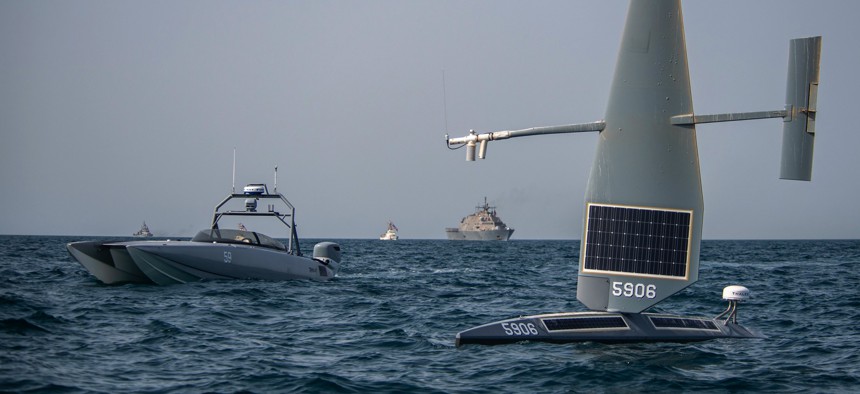
A Saildrone Explorer, Devil Ray T-38 unmanned surface vessel, littoral combat ship USS Sioux City (LCS 11), U.S. Coast Guard cutter USCGC Baranof (WPB 1318) sail in the Persian Gulf on June 26, 2022. U.S. Navy / Chief Mass Communication Specialist Roland A. Franklin
U.S.-Led Drone Fleet Starting To Come Together in Middle East
Bahrain, Kuwait pledge to chip in unmanned surface vessels for maritime surveillance and incident response, 5th Fleet says.
A proposed fleet of 100 unmanned craft in Middle East waters is starting to come together, with the U.S. Navy on track to provide 20 surface drones by next month and two other countries promising to chip in, the 5th Fleet commander said Wednesday.
But it remains unclear just how many drones Bahrain and Kuwait will provide, or which other countries will ultimately fill out the envisioned fleet.
“We’ll see. And we’ll leave it all up to them,” Vice Adm. Brad Cooper told reporters at the Pentagon.
In February, Cooper announced a goal of having 100 unmanned surface vessels patrolling the Persian Gulf, Red Sea, and other regional waters by the end of summer 2023. The region is already home to the year-old Task Force 59, the Navy’s hub for experimenting with unmanned systems and artificial intelligence.
Cmdr. Tim Hawkins, a spokesman for 5th Fleet, said in an email that it is up to Kuwait and Bahrain to decide the number of drones they want to contribute and would not comment on the status of their decisions or processes.
The exact drone platforms in the fleet will be a mix depending on what each country picks, but Cooper believes many will probably be U.S-made drones because “we have the most capable that are out there.”
“I really like the direction we're going with partners in their intent. They all see the inherent advantage of these platforms,” he said. “And of course, we're going to defer to them on what's best for their country in terms of numbers, the type, the style. They’ll make the right decision for them, both for countries that are in the region, and countries that are outside the region.”
The Persian Gulf region is a major area for maritime commerce, as well as smuggling of drugs and weapons. The drones will work with manned ships to expand how the U.S. and other countries operate in the region.
“I don't think it's difficult to imagine how you have your manned platforms out there doing business as they do today, and supplemented by 100, or 50, or you pick the number out there around the Arabian Peninsula,” Cooper said about the fleet during a virtual event with the Navy Memorial earlier on Wednesday. “You can simply see more than we see today, and I think we'll find ourselves in a better deterrent posture. And we'll find ourselves in a position to be able to use manned vessels more effectively if we do detect some sort of malign activity.”
Not only do the surface drones help countries extend their view of the environment beyond their current systems, the artificial intelligence onboard also enables them to find any changes in the environment.
“When there's something different in that pattern of life, it will alert the platform, it will begin to take pictures of it, and send that back to a Navy command center, where a human being then makes a decision on what to do about it,” Cooper told reporters. “So that may sound fairly rudimentary, but if you're looking at this picture today in the Arabian Gulf, you know, there's about 8,000 ships that are underway doing something. There'd be no human being that could possibly pick out that movement that's outside of the pattern of life. But what we've seen is AI can do it [and] it's pretty accurate.”
The 100 surface drones in the fleet will mostly be of two types: long-duration monitors like the Saildrones and fast response vessels like the Devil Ray.
“The two in combination work well for persistent [intelligence, surveillance, and reconnaissance],” Cooper said during the virtual event. “And then when a human being makes a decision on how to respond, if you want to respond with unmanned, you can get out there quickly.”
The Pacific may one day have its own drone fleet. Everything they are doing in 5th Fleet with drones can be used in other regions, Cooper said.
“My expectation is we're going to continue to mature what we do, and we'll make an assessment of what it looks like in other theaters. We have participated in exercises already in other fleets,” he said. “There's a tremendous degree of applicability in other fleets.”





